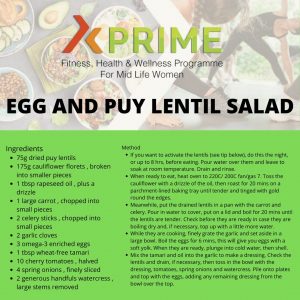What to eat to ease the menopause…
The power of plants
Phytoestrogens are plant nutrients that mimic the effects of oestrogen in the body and are useful in the early years of menopause. That said, it’s never too late (or too early) to add these valuable plant compounds into your diet. You’ll find them in plant foods like flaxseed, fermented soy products (like tamari, miso and tempeh) as well as in beans and pulses, including lentils and wholegrains.
Our bodies convert these phytonutrients into oestrogen-like compounds, with the help of friendly gut bacteria, so it’s important to maintain good gut health. Soya is known for being a source of phytoestrogens, but focus on the fermented varieties, because fermentation breaks down soy’s natural compounds, which makes it easier for the body to access the useful minerals.
Heart-friendly foods
After the menopause, a woman’s risk of cardiovascular disease matches that of a man’s because of the loss of protective oestrogen. Oily fish like salmon, mackerel, sardines and trout contain beneficial fats that help prevent clots, improve blood triglyceride levels and boost circulation. Aim for 2-4 portions per week and use gentle methods of cooking, such as poaching and baking, to protect the beneficial oils. Where budget permits, buy wild rather than farmed fish for its superior fat composition.
Feast on other heart-friendly foods like avocado and nuts, including almonds and seeds like chia and pumpkin, as well as extra-virgin olive oil as it’s rich in protective compounds called polyphenols.
Support your body’s natural detoxification
Your diet can be a powerful tool in managing oestrogen levels, particuarly important these days as we are now commonly exposed to synthetic oestrogen through food, water and even the air we breath. Sulphur-rich garlic and onion support liver detoxification. Compounds in cruciferous veg, including cabbage, cauliflower and broccoli help balance oestrogen levels. Vitamin B6 and magnesium help us to maintain a healthy oestrogen balance, so include plenty of oats, nuts, seeds and wholegrains, as well as green leafy veg in your diet.
Increase your calcium
If you only do one thing, increase the calcium-rich foods in your diet as this will help protect you from osteoporosis and heart disease while minimising mood swings. You don’t need to rely on dairy – green, leafy vegetables including spinach as well as canned fish with edible bones, dried fruit like dates and nuts are packed with calcium.
What to be aware of…
Maintain a healthy weight
If you are underweight you are more likely to experience the classic menopausal symptoms like hot flushes. This is because fat cells boost low levels of oestrogen in the body by producing a special type of oestrogen called oestrone. Try to maintain a healthy weight through a balanced diet and plenty of exercise.
Watch your sugar intake
Lower levels of oestrogen make our cells less responsive to the hormone, insulin, so you may notice more disruption to blood sugar levels. Focus on eating a low-GI (GIycemic Index) diet – replacing refined, white carbs with wholegrain versions and eat little and often to stabilise energy levels.
Try this great recipe today:

Do you want to learn more about how you can serve menopausal women? CLICK HERE


Leave a Reply